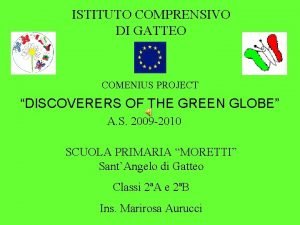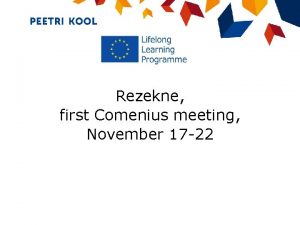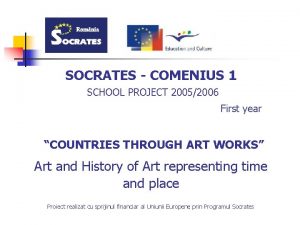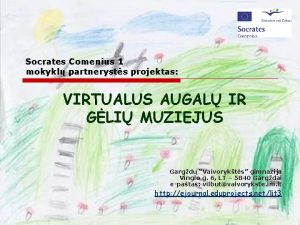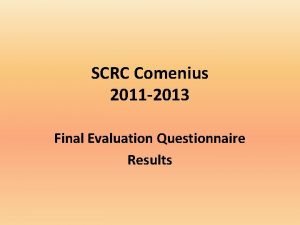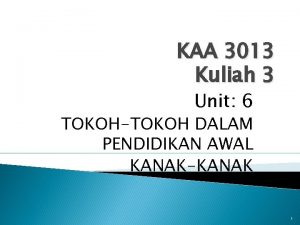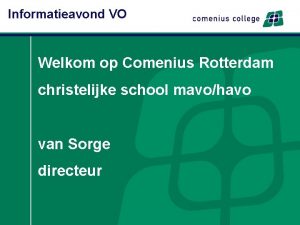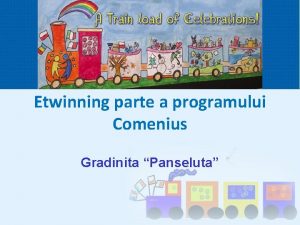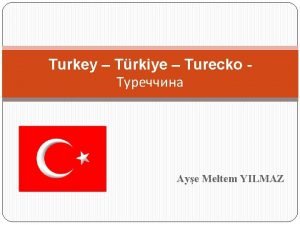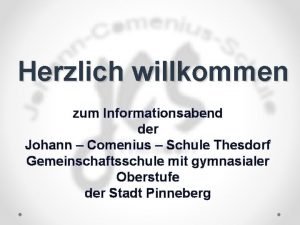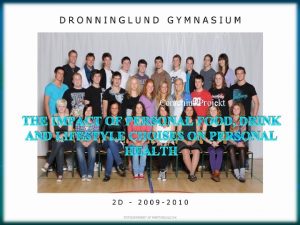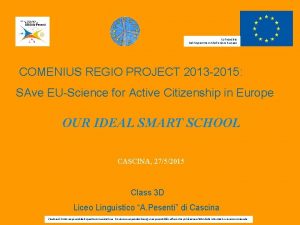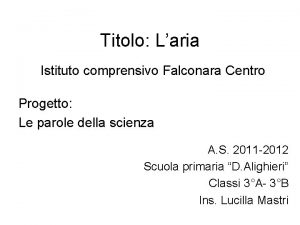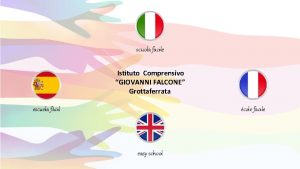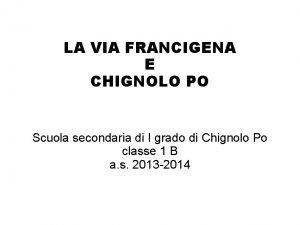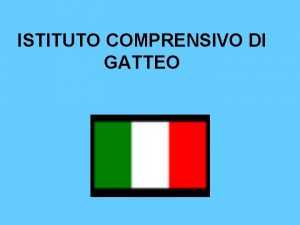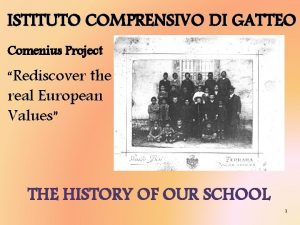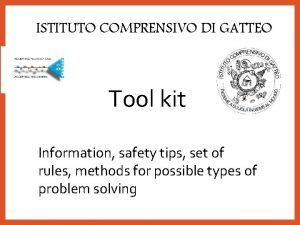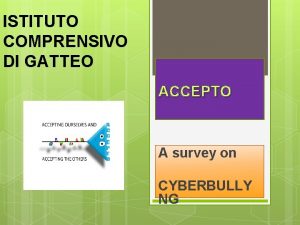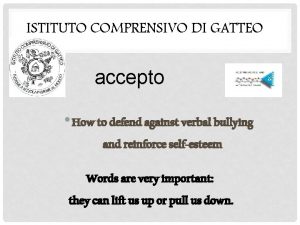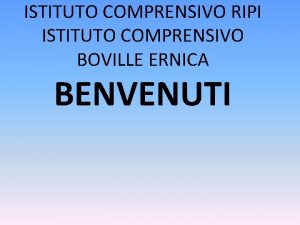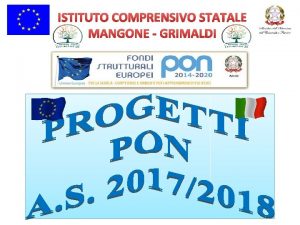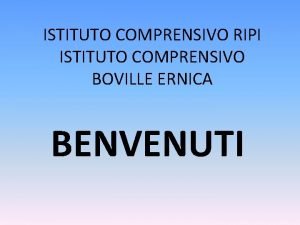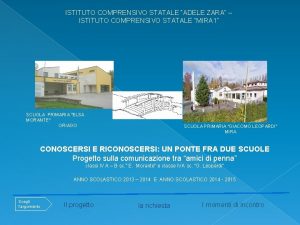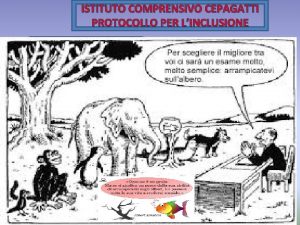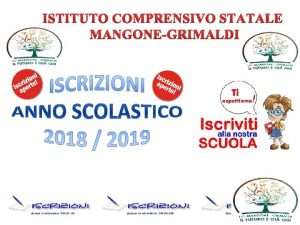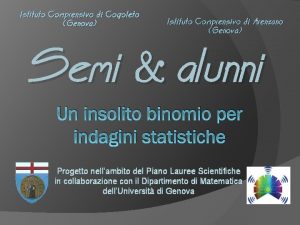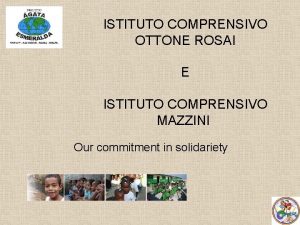ISTITUTO COMPRENSIVO di GATTEO Comenius project R R


















- Slides: 18

ISTITUTO COMPRENSIVO di GATTEO Comenius project R. R. E. V. The week of Healthy Food

BALANCED DIET Our food, where possible, must be varied and balanced; in short we must buy all the different types of food in way of assuring that we receive all the necessary nutrients.

The Risks of Unhealthy Food • It is better to avoid the excessive consumption of fried food because cooked fat is not healthy. • One must also avoid products with a lot of sugar as it can overwork the liver, cause obesity and tooth decay. • An excessive amount of alcohol is harmful to the liver, while the excessive consumption of sugary and gassy drinks can bring about diabetes.

Survey about breaktime at school During the school year, our class, together with the technology teacher, have carried out a teaching unit on nutrition education which allowed us to understand how we should divide the calories in the meals of the day. However it’s difficult to put into practice what we learned and at school in the breaktime there a lot of temptations and we students are out of our parents’ control. We did a survey among the students of our school in order to determine what students have in the breaktime. Our survey showed that on 220 pupils 63% of pupils bring a snack from home 37% of pupils buy it at the baker’s or from vending machines at school 12% of pupils doesn’t have a snack Regarding food preferences: 27% choose sandwiches, or pizza or flatbread, crackers 47% sweet snacks , fresh or prepacked snacks 17% crisps and salty snacks 9% fruit, vegetables, yoghurt

Do you usually have a snack at breaktime? yes 88% no 12% yes no 88%

Do you usually bring a snack from home? yes 63% no 37% 63% yes no

Do you buy your snack at the baker’s or from the vending machine at school? bakery 63% vending machine 37% 35% 65% fornaio Bakery macchinette Vending machine

Do you prefer sweet or salty snacks? sweet snacks 38% salty snacks 62% 38% 62% sweet snack salt snack

What do you usually eat? sandwiches cakes crisp and snack 14% 9% 17% crakers home made sweets 13% 27% prepacked fruit and snacks vegetables 11% cereals yoghurt 1% 2% 6% 30% 25% sandwich cake 20% crisp and snack 15% crakers home made sweets 10% packaged snacks 5% fruits and vegetables cereals ur t gh yo ls ea ce r bl ta ge its an d ve ed fru ck ag pa es ks ee sw e ad ho m e m isp sn ac ts s er ak sn d an cr ac k ke ca cr sa nd w ich 0% yoghurt

As we don’t have lunch at school we organized a healthy snack in the breaktime. Everyone brought something to eat avoiding any kindof junk food. Fruit: kiwis, straberries, apples, bananas, …. Vegetables: carrots, cucumbers, tomatoes, fennels, faves, courgettes……. . Rice crackers, ham and cheese sandwiches, apricot pie, bread and berries jam and honey, yoghurt, orange juice and water





We liked this experience very much. From then on we’ll try to improve our food habits and induce our peers to reduce junk food

During the week of healthy food…. Students developed the idea to create a poster, working closely with the technology teacher. The poster was concerned with detailing healthy food as well as highlighting food that we should avoid. The students attempted to involve their familes in encouraging them to eat healthy food. At the end of the week they compared their experiences.


 Istituto comprensivo gatteo
Istituto comprensivo gatteo Istituto comprensivo di gatteo
Istituto comprensivo di gatteo Istituto comprensivo bocchi parma
Istituto comprensivo bocchi parma Comenius
Comenius Socrates comenius
Socrates comenius Socrates comenius
Socrates comenius Comenius 2011
Comenius 2011 Sumbangan john amos comenius
Sumbangan john amos comenius Comenius rotterdam
Comenius rotterdam Komensk
Komensk Jan mos
Jan mos Gradinita comenius
Gradinita comenius Comenius assistant
Comenius assistant Johann-comenius-schule thesdorf
Johann-comenius-schule thesdorf Comenius projekt
Comenius projekt Cofinanziato
Cofinanziato Istituto comprensivo falconara centro
Istituto comprensivo falconara centro Giovanni falcone grottaferrata
Giovanni falcone grottaferrata Istituto comprensivo di chignolo po
Istituto comprensivo di chignolo po

